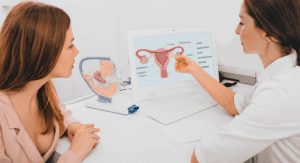 As women and mothers, we at Birmingham Mom Collective (BMC) deeply value learning and sharing about women’s health. No matter what our unique health situation, we are all in this together! Our hope is to provide helpful conversations that inform and offer encouragement and support.
As women and mothers, we at Birmingham Mom Collective (BMC) deeply value learning and sharing about women’s health. No matter what our unique health situation, we are all in this together! Our hope is to provide helpful conversations that inform and offer encouragement and support.
In recognition of Endometriosis Awareness Month this March, we turned to the experts at UAB Medicine to learn more about this condition, including signs to look for and treatment options. We were thrilled to talk with Rick Burney, MD, MSc, who serves as the director of the Division of Reproductive Endocrinology and Infertility (REI) for UAB Medicine’s Department of Obstetrics and Gynecology. Specializing in advanced fertility treatment, endometriosis, tubal infertility, and reproductive endocrine disorders, he brings a wealth of knowledge to our conversation today!
What is endometriosis?
Endometriosis is defined as the presence of endometrium (tissue that typically lines the inside surface of the uterine cavity) in locations outside the uterus, to include the lining of the pelvis (peritoneum), the ovaries, bowel and bladder. In rare instances, endometriosis can be found within a surgical scar, the diaphragm, or even the lungs! The most widely accepted mechanism for the lining of the uterus to spread to the pelvis is retrograde menstruation, during which menstrual tissue travels through open fallopian tube(s) to the pelvis and implants on pelvic organs. In most women, this menstrual tissue is cleared. But in others, the tissue implants and grows to become endometriosis. The factors that predispose women to develop endometriosis are an active area of research.
What are common symptoms?
Endometriosis is a leading cause of chronic pelvic pain, particularly pain before and during menstruation, during intercourse, or during a bowel movement. Many women with endometriosis also note low back pain and headaches at certain times during the menstrual cycle. Endometriosis is also associated with vaginal spotting for two or more days, particularly in women with infertility.
How many women are affected by it, and how does it affect reproductive health?
Endometriosis is one of the most prevalent gynecologic conditions, affecting up to one in 10 women of reproductive age, which is approximately 190 million women and teen girls worldwide. As one of the most common causes of pelvic pain and infertility, endometriosis has a significant impact on reproductive health of individual women and the general health system.
How is it detected/diagnosed?
Awareness is on the rise–in 2018, “What is endometriosis?” was the third most searched health question, with over 31 million inquiries. The average delay in diagnosis of endometriosis, from onset of signs and symptoms to definitive diagnosis, is 7 years, partly owing to the absence of a laboratory test to diagnose the condition. Definitive diagnosis of endometriosis is by surgical (typically laparoscopic) visualization of endometriosis implants. Ovarian endometriosis, also known as endometriomas, can be diagnosed by pelvic ultrasound. Magnetic resonance imaging (MRI) can detect both endometriomas and deep infiltrating endometriosis.
What steps should a woman take if she suspects she may have endometriosis?
A discussion with an OB/GYN provider is an important first step. A pelvic ultrasound or MRI may reveal endometriosis. Because pelvic pain and infertility have many causes, a series of visits and possibly surgery may be necessary to make a diagnosis. Ultimately, the approach depends on the patient’s goals.
What treatment options does the REI Division at UAB Medicine offer?
The REI Division at UAB Medicine provides sub-specialty care for patients with endometriosis associated infertility. This includes advanced surgical treatment and full-spectrum fertility care to include IVF. Optimal management of endometriosis requires a multidisciplinary team of specialists that are well-coordinated at centers like UAB. Because no two patients with endometriosis are alike, the approach to treatment needs to be personalized and all decision-making should be shared. Increasing evidence indicates that endometriosis is a progressive disease that starts during adolescence. For patients with extensive ovarian endometriosis, fertility preservation options such as oocyte (egg) crypto-preservation can be considered at centers like UAB Medicine.
Interested in learning more? Visit UAB Medicine’s website to read about their services and to make an appointment. We are grateful to UAB for their expertise and resources!












